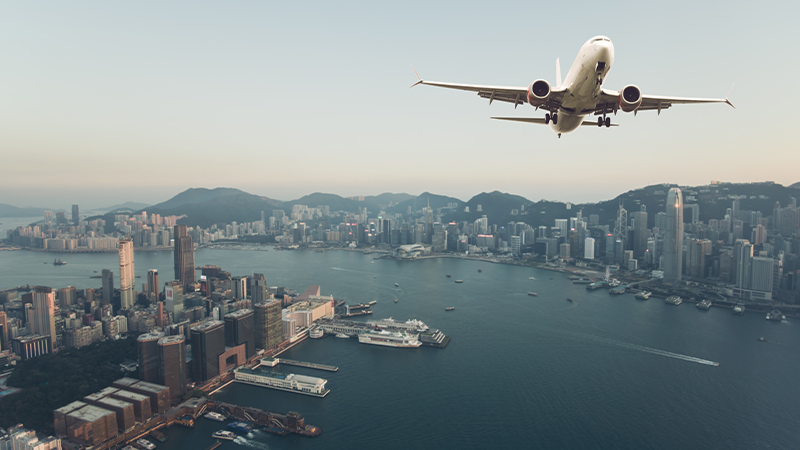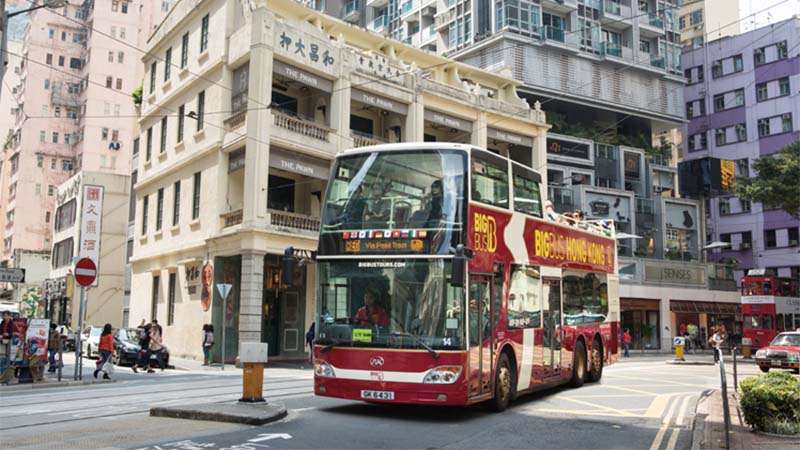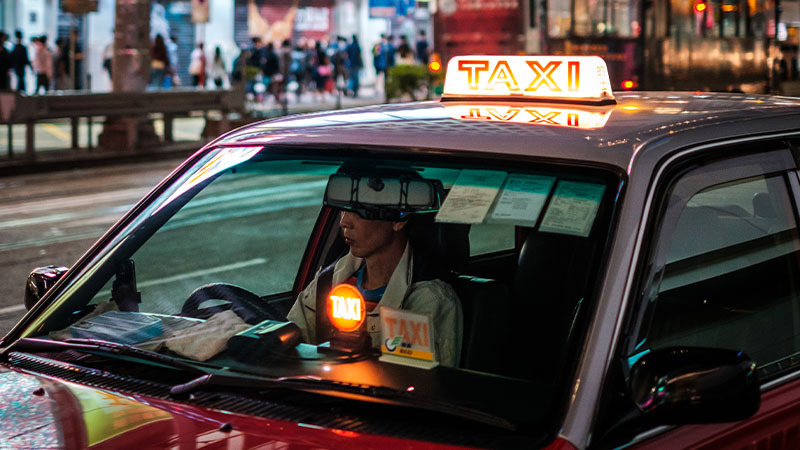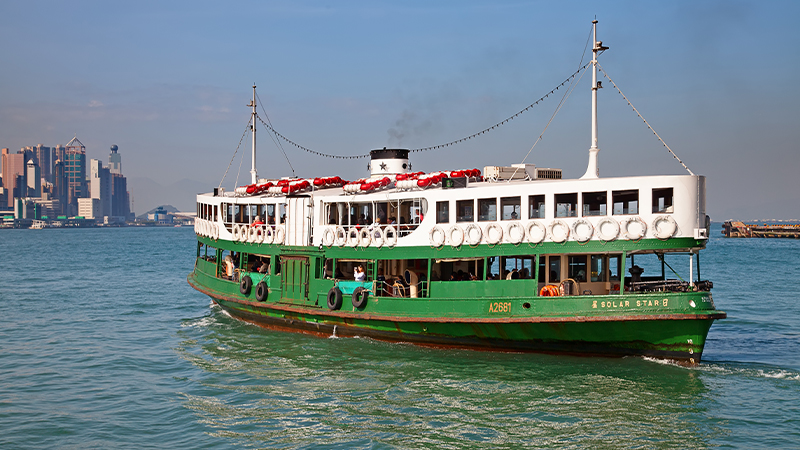Despite the city’s size and population, getting from A to B in Hong Kong is relatively easy. Hong Kong’s public transport system is fast, efficient and usually very cheap! With an MTR system that’s easily among the world’s best, a good bus network, mini buses, reasonably priced taxis and a few other fun ways to travel, it’s very easy to survive here without a car.
Planes
Whether you’re arriving in Hong Kong for the first time, or you’re an old hand who comes and goes frequently, it’s likely you’ve been impressed at the facilities and operations at Hong Kong International Airport (HKIA). While 2020 and 2021 have obviously been an aberration for the aviation and tourism industries (passenger volume was down by 98.6 percent for the fiscal year!), in 2019, over 71 million passengers were handled by HKIA; and there’s rarely a bad word spoken about the facility by anyone who travels regularly.

Gongs for HKIA
Hong Kong’s international airport features very prominently in voting in the Skytrax World Airport Awards each year, including regular top five spots for Best Airport, and a win for World’s Best Airport for Dining in 2019.
Eye on the future
Despite the pandemic, HKIA is fully in expansion mode, with a third runway scheduled to be operational perhaps as early as 2022, and the 11 SKIES development (11-skies.com) – set to be HK’s largest retail, dining and entertainment facility – scheduled to open next to the airport in phases between 2022 and 2025.
Trains and Trams
MTR
The MTR network consists of 11 lines, including the South Island line, which opened in December 2016. It also includes a service to Disneyland and the Airport Express. A light rail system runs between Yuen Long and Tuen Mun in the New Territories and you can also take a train to the mainland, crossing the border at Lok Ma Chau and Lo Wu.
New In 2021
MTR stations keep springing up! The latest two to open, in June 2021, are Sung Wong Toi and To Kwa Wan. They connect the existing West Rail Line to Phase 1 of the Tuen Ma Line, completing a 56km line that runs through 27 stations from Tuen Mun to Wu Kai Sha. For the record, that’s a 73-minute MTR journey!
High-Speed Rail
If you fancy a trip up to mainland China, the new high-speed rail system is the perfect way to do it once travel restrictions are lifted. The service was opened in 2018 and connects Hong Kong to 44 cities around China. Remember, all foreign travellers require passports and China visas, even for the shortest journeys.
Tram
Hong Kong trams, known affectionately as “ding dings”, may not be the fastest way to travel, but sitting on the top deck provides a great view. You board at the back and pay at the front as you exit at the end of your journey (using Octopus card or the correct small change). Trams operate between Kennedy Town and Shau Kei Wan from about 5.30am to midnight.
Cars & Buses
Taxis
Hong Kong’s taxis are cheap compared to many other major cities. They’re also generally reliable, though do keep Google Maps open on your phone and a Cantonese translation of your destination on hand.
There are three different coloured taxis:
- Blue taxis are only permitted to travel on Lantau island.
- Green taxis don’t leave the New Territories.
- Red taxis operate on Hong Kong Island and Kowloon, but be aware that if Kowloon cabbies drop someone off on Hong Kong Island, they can only pick up customers heading back to Kowloon and vice versa.
You can work out if a taxi can take you by doing a wavelike gesture with your hand to let the driver know you want to cross the harbour. Also note that it can be difficult to get a cab during morning and evening rush hours, when it’s raining, or when many drivers are making their daily shift change between 4 and 4.30pm.
Get the app!
HKTaxi is a basic ride-hailing app where you enter your pickup location and contact number and wait for a driver to contact you. Uber is available in Hong Kong but it will normally cost more than a taxi.
Buses
A strong network makes bus travel in Hong Kong reasonably easy – although buses can get crowded. In addition, more than 4,350 minibuses are in service across the city, carrying up to 19 passengers. Green minibuses have set stops, but red minibuses will stop anywhere along their route. Once the bus is full, the driver will not accept new passengers. You need to pay when you get on the bus with either cash or an Octopus card. Shouting “yau lok” tells your driver in Cantonese that you want to get off if you can’t see a bell.

Bridge To Macau
At 55 kilometres long, the Hong Kong-Zhuhai-Macau bridge (opened in 2018) is the fastest and most convenient way to get to nearby Macau. Various bus companies run shuttles across the bridge and back – prices vary, depending on the company running the service, and a trip one way should take about 45 minutes, excluding immigration.
Boat
Ferries remain an active and necessary form of transport in Hong Kong. Aside from Hong Kong’s famous Star Ferry, which still shuttles commuters and tourists from Central and Wan Chai to Tsim Sha Tsui’s Clock Tower, other vessels provide regular services for residents of the outlying islands. Lamma, Cheung Chau, Discovery Bay, Ma Wan’s Park Island, Mui Wo and Peng Chau have dedicated daily services leaving from the Central Ferry Piers. Other ferries shunt from Aberdeen, Wan Chai, Hung Hom and North Point.
New for 2021
A new water taxi service was being trialled in July 2021, with boats stopping at Hung Hom, TST East and Central. The service is aimed primarily at tourists and sightseers, with a full adult fare costing HK$48.
Ferry To Macau
Ferries are available from multiple places in Hong Kong to Macau – from the Hong Kong Macau Ferry Terminal in Sheung Wan, from the China Ferry Terminal in Kowloon and (only for those transferring through Hong Kong, not people originating in Hong Kong) from the SkyPier at Hong Kong International Airport.
Escalators
The outdoor escalator in Central and Mid-Levels is the longest outdoor covered escalator system in the world. And while it may be a tourist destination in its own right, it’s also a functional method of traversing a very hilly part of Central. While this particular escalator gets all the glory, there are others in Hong Kong, such as on Centre Street in Sai Ying Pun. The escalators are free to use.
About the Central-Mid-Levels Escalator
We’ve all been on it – some of us use it every day; Hong Kong’s Central-Mid-Levels Escalator is, according to Guinness World Records, the longest outdoor covered escalator system on the planet. Opened in 1993, the system stretches for 800 metres and covers an elevation of 135 metres. It has 75 CCTV cameras along its length and is used by more than 70,000 people a day. Total travel time from top to bottom is around 15 to 20 minutes. The escalator is currently undergoing a major four-year renovation, which is expected to be finished by 2022.
This article first appeared in the City Guide 2021/22 issue of Expat Living magazine. Subscribe now so you never miss an issue.
See more in our Living in Hong Kong section!










